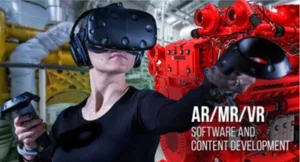Virtual reality manifested an extremely lean floor presence in the two main expo halls at InfoComm 2018, much to my surprise. One of the brightest VR stars shining, however, was the Inhance Digital booth, a company serving up custom-developed VR.

According to Maziar Farzam, the president of LA-based Inhance Digital, the company “can help an organization produce VR faster cost-effectively and allow the organization to start building content without having to invest in deep engineering, software development expertise, artists and programmers.” See this on-the-floor explanation by CEO Penn Arthur:
This value proposition captured my attention almost immediately for two reasons: first, in education circles, there is more interest in producing VR than there is in buying off-the-shelf VR; and last, I keep hearing from frustrated educators about their dissatisfaction with existing VR content development tools. It’s a common theme that educators are looking for something better, tools Inhance Digital’s VR at IC18that can give them more flexibility and power. Inhance enables educators to bring their own models or their own environment in play, helping them tell stories in a VR environment, and port work that over to an LMS (learning management system).
Inhance Digital seems to have the right roots and pedigree to fit this bill. Their team has been working together in the educational media arena since 1998. According to Farzam,“That’s where our hearts and roots are at.”
Fast forward, Inhance Digital is exploring STEM and STEAM education funding streams now so prevalent in the ed market. As I dug deeper, I learned that Inhance tries to bring a storytelling and game-based learning perspective to bear, which is also appealing to modern-thinking educators. In an interesting revelation, Inhance’s educational customers are pushing more towards AR/MR at every level, versus “requesting pure VR content development”, according to Farzam. Some of their more impressive brand-embedded projects that I reviewed include:
Amgen Residual Cancer AR Discovery Game
AB Mauri VR : Science behind Bread Making
Shell Deep Water Exploration VR
Inhance also provides a virtual-reality collaboration tool called Workspaces (in partnership with Tsunami VR). In the past, they have helped an impressive host of industry, medical or traditional educators build use cases using VR, develop their own presentations in a VR environment, and customize and extend existing 3D models and assets owned by their customers. They can do all of the work for busy educators or they can hold their hands, walking them through their own internal development efforts. One of their most interesting collaborations, for example, involves applying immersive environments to medical patient education and visualization purposes in order to improve pre- and post-op outcomes. “Imagine using virtual reality as an alternative to opioid-based chronic pain management for patients,” teased Farzam.
I asked Maziar Farzam what differentiated Inhance Digital from his competitors, and he gave an answer that helps explain why his current customer base looks like a hall-of-fame roster: “We pride ourselves on being great storytellers; we support work with scientific, evidence-based design; we offer a great knowledge of the VR production pipeline; we have a super creative team; and we are experienced in a broad array of educational and industry domains.” He added “and we have a primary focus on the customer experience.”
In the rawboned footprint of VR scarcely fielded at InfoComm18, Inhance Digital stands out as a healthy and refreshing measure of the potential for this burgeoning industry, rather than mere frothing or flapdoodle.—Len Scrogan

